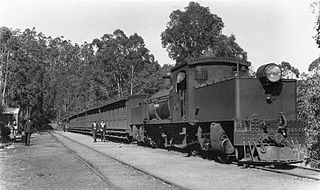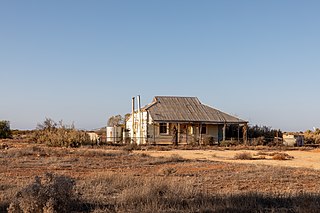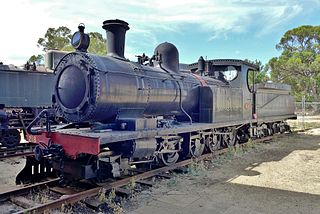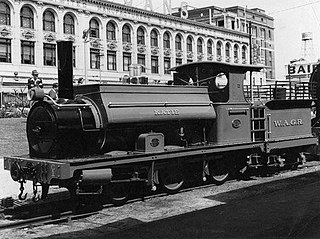External links
![]() Media related to East Perth locomotive depot at Wikimedia Commons
Media related to East Perth locomotive depot at Wikimedia Commons
East Perth Locomotive Depot (also known as East Perth loco sheds) was a major steam locomotive depot for the Western Australian Government Railways from a year before the end of the First World War in 1917 [1] until the end of the steam railway era on its railway system in 1970/1971. [2] [3] The previous locomotive depot had been located west of the Perth railway station. [4]
It was also commonly known as East Perth loco sheds [5] [6] and also the East Perth Depot. [7]
The depot was operational from 1917. [8]
There was a turntable at the western end of the yard. [9]
It[ clarification needed ] was located just east of the main railway terminus for the system at what is now Perth station. It was removed in 1969 to make way for the new East Perth railway station and the Westrail Centre that centralised railway administration offices of the government railway system, that had previously been scattered around a large number of buildings near the Perth station. [10]
Jack Stanbridge devotes 41 photos on 10 pages of his first volume of his collection known as 70 years of rails & wire in Western Australia for reflections about the Depot. [11] [12]
In the late twentieth century numbers of former employees who had worked at the depot, were interviewed for the oral history record. [13] [14]
Organised labour had reason to strike and raise issues of conditions during the existence of the depot. [15] [16] Some complaints had also been made collectively without union involvement. [17]
{{citation}}: Check |isbn= value: checksum (help){{citation}}: |author2= has generic name (help)CS1 maint: multiple names: authors list (link) ![]() Media related to East Perth locomotive depot at Wikimedia Commons
Media related to East Perth locomotive depot at Wikimedia Commons

The Eastern Railway is the main railway route between Fremantle and Northam in Western Australia. It opened in stages between 1881 and 1893. The line continues east to Kalgoorlie as the Eastern Goldfields Railway.

North Fremantle railway station is a railway station on the Transperth network. It is located on the Fremantle line, 16.2 kilometres from Perth, serving the Fremantle suburb of North Fremantle.

The Trans-Australian Railway, opened in 1917, runs from Port Augusta in South Australia to Kalgoorlie in Western Australia, crossing the Nullarbor Plain in the process. As the only rail freight corridor between Western Australia and the eastern states, the line is economically and strategically important. The railway includes the world's longest section of completely straight track.

Western Australian Government Railways (WAGR) was the state owned operator of railways in the state of Western Australia between October 1890 and June 2003. Owned by the state government, it was renamed a number of times to reflect extra responsibility for tram and ferry operations that it assumed and later relinquished. Westrail was the trading name of the WAGR from September 1975 until December 2000, when the WAGR's freight division and the Westrail brand were privatised. Its remaining passenger operations were transferred to the Public Transport Authority in July 2003.

The Mundaring Weir branch railway was constructed from Mundaring, Western Australia to the site of the Mundaring Weir, and opened on 1 June 1898.

The Westland was the name given in 1938 to the overnight train operated by the Western Australian Government Railways (WAGR) with sitting and sleeping cars between Perth and Kalgoorlie, where it connected with the Trans-Australian service to Adelaide.

Rawlinna is an isolated locality on the Trans-Australian Railway in Western Australia, about 900 kilometres east of Perth, 380 kilometres (240 mi) east of Kalgoorlie and 350 kilometres west of the Western Australia / South Australia border. It is on the Nullarbor Plain, about 50 kilometres from its western fringe; the topography is flat and well grassed, with saltbush and bluebush, with small belts of myall and myoporum trees. Annual rainfall is 288 millimetres. Maximum daytime temperatures are typically 38 °C (100 °F) through summer and 19 °C (66 °F) during winter. In 2016, the population in the area was recorded as 30 people.

Railways in Western Australia were developed in the 19th century both by the Government of Western Australia and a number of private companies. Today passenger rail services are controlled by the Public Transport Authority through Transperth, which operates public transport in Perth, and Transwa, which operates country passenger services. Journey Beyond operates the Indian Pacific.

The Goldfields Water Supply Scheme is a pipeline and dam project that delivers potable water from Mundaring Weir in Perth to communities in Western Australia's Eastern Goldfields, particularly Coolgardie and Kalgoorlie. The project was commissioned in 1896 and completed in 1903.

Nungarin is a town located in the north east of the Wheatbelt region of Western Australia, approximately 278 kilometres (173 mi) east of Perth and 39 kilometres (24 mi) north of Merredin. It is the main town in the Shire of Nungarin. At the 2006 census, Nungarin had a population of 142.

Merredin railway station is located on the Eastern Goldfields Railway in Western Australia. It is in the town of Merredin.

Rail Heritage WA is the local trading name of the Australian Railway Historical Society Inc.

The network of railway lines in Western Australia associated with the timber and firewood industries is as old as the mainline railway system of the former Western Australian Government Railways system.

The Western Australian Government Railways (WAGR) O Class was a class consisting of fifty-six 2-8-0 steam locomotives which were introduced by the WAGR between 1896 and 1912. Despite them being tender locomotives, they also featured short boiler side tanks for additional water storage. A useful feature for the long distances required by operation on Western Australia's country lines.

The WAGR C Class was a class of steam locomotives built by Robert Stephenson and Company for the Western Australian Government Railways in 1880 to the same design as the NZR F class.

The WAGR W class is a class of 4-8-2 steam locomotives operated by the Western Australian Government Railways (WAGR) between 1951 and 1972.

The Sandstone branch railway was a branch railway line between Mount Magnet and Sandstone in the Mid West region of Western Australia.
The Northampton railway line, also referred to as the Geraldton to Ajana railway line, ran from Geraldton through Northampton and on to Ajana in Western Australia. It operated between 1879 and 1957. It was the first government railway constructed in Western Australia.

The WAGR A class was a class of 2-6-0 steam locomotives designed by Beyer, Peacock & Co and operated by the Western Australian Government Railways (WAGR) between 1881 and 1955.

Toodyay railway station is located on the Eastern Railway in the Avon River town of Toodyay in Western Australia.